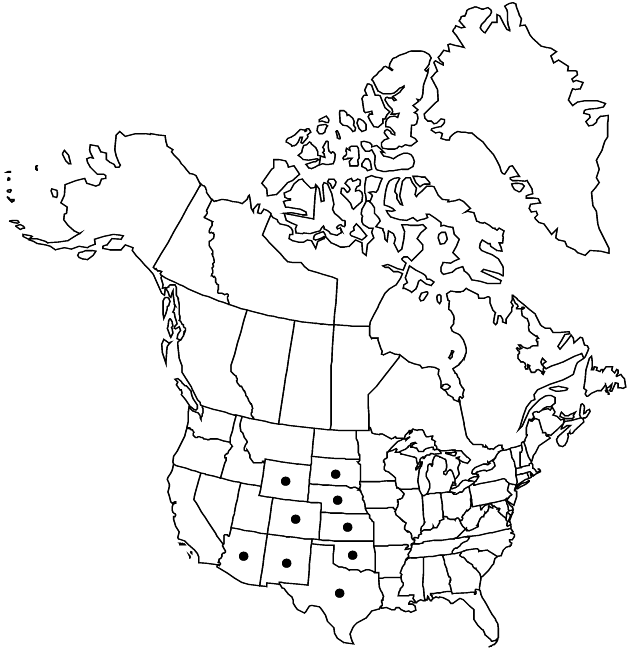Difference between revisions of "Senecio riddellii"
Fl. N. Amer. 2: 444. 1843.
FNA>Volume Importer |
imported>Volume Importer |
||
| (3 intermediate revisions by 2 users not shown) | |||
| Line 6: | Line 6: | ||
|place=2: 444. 1843 | |place=2: 444. 1843 | ||
|year=1843 | |year=1843 | ||
| + | }} | ||
| + | |special_status={{Treatment/ID/Special_status | ||
| + | |code=E | ||
| + | |label=Endemic | ||
}} | }} | ||
|basionyms= | |basionyms= | ||
| Line 11: | Line 15: | ||
|name=Senecio filifolius var. fremontii | |name=Senecio filifolius var. fremontii | ||
|authority=Torrey & A. Gray | |authority=Torrey & A. Gray | ||
| + | |rank=variety | ||
}} {{Treatment/ID/Synonym | }} {{Treatment/ID/Synonym | ||
|name=Senecio riddellii var. parksii | |name=Senecio riddellii var. parksii | ||
|authority=Cory | |authority=Cory | ||
| + | |rank=variety | ||
}} {{Treatment/ID/Synonym | }} {{Treatment/ID/Synonym | ||
|name=Senecio spartioides var. fremontii | |name=Senecio spartioides var. fremontii | ||
|authority=(Torrey & A. Gray) Greenman | |authority=(Torrey & A. Gray) Greenman | ||
| + | |rank=variety | ||
}} {{Treatment/ID/Synonym | }} {{Treatment/ID/Synonym | ||
|name=Senecio spartioides var. parksii | |name=Senecio spartioides var. parksii | ||
|authority=(Cory) Shinners | |authority=(Cory) Shinners | ||
| + | |rank=variety | ||
}} {{Treatment/ID/Synonym | }} {{Treatment/ID/Synonym | ||
|name=Senecio spartioides var. riddellii | |name=Senecio spartioides var. riddellii | ||
|authority=(Torrey & A. Gray) Greenman | |authority=(Torrey & A. Gray) Greenman | ||
| + | |rank=variety | ||
}} | }} | ||
|hierarchy=Asteraceae;Asteraceae tribe Senecioneae;Senecio;Senecio riddellii | |hierarchy=Asteraceae;Asteraceae tribe Senecioneae;Senecio;Senecio riddellii | ||
| Line 48: | Line 57: | ||
-->{{#Taxon: | -->{{#Taxon: | ||
name=Senecio riddellii | name=Senecio riddellii | ||
| − | |||
|authority=Torrey & A. Gray | |authority=Torrey & A. Gray | ||
|rank=species | |rank=species | ||
| Line 62: | Line 70: | ||
|publication title=Fl. N. Amer. | |publication title=Fl. N. Amer. | ||
|publication year=1843 | |publication year=1843 | ||
| − | |special status= | + | |special status=Endemic |
| − | |source xml=https:// | + | |source xml=https://bitbucket.org/aafc-mbb/fna-data-curation/src/2e0870ddd59836b60bcf96646a41e87ea5a5943a/coarse_grained_fna_xml/V19-20-21/V20_1246.xml |
|tribe=Asteraceae tribe Senecioneae | |tribe=Asteraceae tribe Senecioneae | ||
|genus=Senecio | |genus=Senecio | ||
Latest revision as of 19:59, 5 November 2020
Subshrubs, 30–100 cm (taproots forming woody crowns). Herbage glabrous. Stems usually multiple (branching upward). Leaves ± evenly distributed (proximal often withering before flowering, pendulous); sessile or obscurely petiolate; blades linear-filiform (or irregularly pinnately divided into linear-filiform lobes), blades or lobes 4–9 cm × 1–5 mm, bases ± linear, ultimate margins entire. Heads 5–20+ in close, corymbiform arrays (involucres campanulate, 7–10 mm diam.). Calyculi usually of 3–8+ lance-linear to filiform bractlets (lengths 1/10–1/3 phyllaries). Phyllaries ± 13, 7–10(–12+) mm, tips green. Ray florets ± 8; corolla laminae (often falling early) 8–10 mm. Cypselae hirtellous. 2n = 40.
Phenology: Flowering mostly mid summer–fall, occasionally spring.
Habitat: Sandy or rocky open sites, especially drying, open, flood plains
Elevation: 600–2500 m
Distribution

Ariz., Colo., Kans., Nebr., N.Mex., Okla., S.Dak., Tex., Wyo.
Discussion
Senecio riddellii intergrades morphologically with S. spartioides. Typically, the former has larger heads with campanulate involucres 7–10 mm diam.; the latter has cylindric involucres rarely more than 6 mm diam.
Senecio riddellii is poisonous to livestock. It is now locally scarce because of efforts to eradicate it.
Selected References
None.